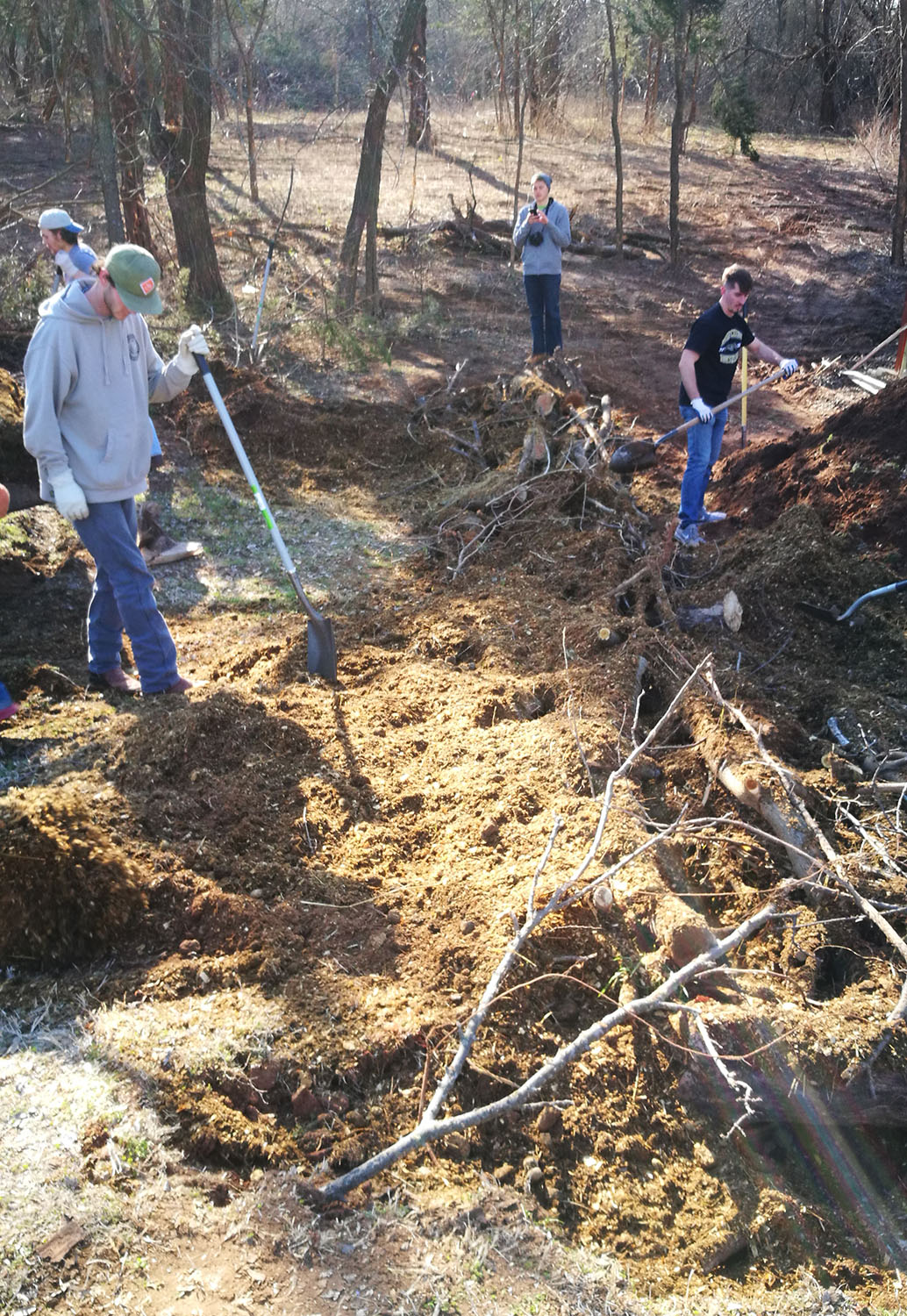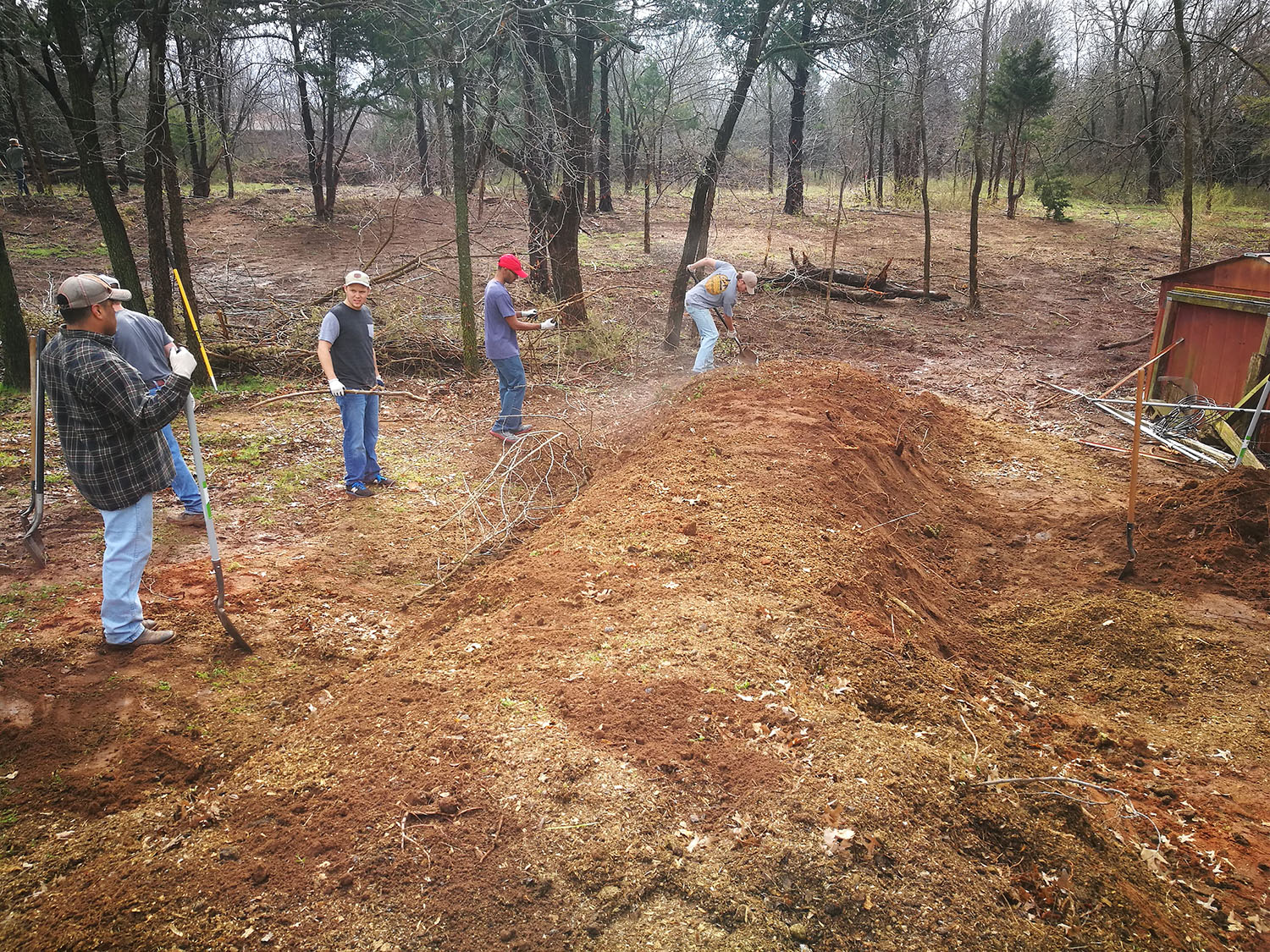Sustainable Landscapes: Creating a Hügelkultur for Gardening with Stormwater Management Benefits
What is a Hügelkultur?
“Hügelkultur” (pronounced hyoo-gul-kulture) is a German word that means mound culture or hill culture. A hügelkultur is a sloped and raised planting bed filled with topsoil, wood, and organic materials. German and European people have practiced it as a gardening method for hundreds of years. Illustration 1 shows what a typical hügelkultur in the field looks like. A well-built hügelkultur is a self-watered, self-composting raised garden with few irrigation and fertilization needs. This garden bed is perfectly designed to capture rainwater runoff for sustainable stormwater management and can serve as a windbreak.
This factsheet describes the benefits and construction of a hügelkultur. A hügelkultur case study built by landscape architecture faculty and students of LA 3894 Sustainable Construction class in Stillwater, Oklahoma demonstrates how to find the best spot for a hügelkultur on a property and what steps it takes to create one.

Illustration 1. A typical hügelkultur
Benefits of Hügelkultur
- Hügelkultur conserves water. It works as a self-irrigated garden and needs little supplemental water if constructed correctly in a location where it can capture surface runoff. As the surrounding surface water runs into the mound, the organic material in the hügelkultur acts as a sponge to absorb the water and wick it up to the roots of the plants.
- Hügelkulture is low maintenance. It requires minimal maintenance due to the drought resistant nature. As with any garden, it will still need weeding.
- Hügelkultur is a sustainable stormwater management practice. It works as a “raised rain garden” with the mound providing a water retention function. Thus, it is a sustainable stormwater management practice as the mound slows down the water runoff and allows a place for water to infiltrate back into the ground.
- Hügelkultur produces food. Growing crops in the beds is a highly regarded self-sufficient farming practice. Wider use of hügelkultur in gardening and agriculture can be an efficient way to increase crop yields and reduce hunger.
- Hügelkultur improves the soil. The organic matters in soil conduct a dynamic self-composting process over time inside the mound. It also is a tool for carbon sequestration and makes use of landscape debris that might otherwise be burned or sent to a landfill.
- Hügelkultur is permaculture. It is a productive practice for gardeners, farmers, children, and homeowners.
- Hügelkultur is easy and affordable. It is in general inexpensive and easily adaptable to different environmental/site situations and materials.
Designing a Hügelkultur
A hügelkultur should be designed with the location in mind, therefore the final garden can take many forms to fit the site. A simple hügelkultur will resemble a long, straight mound, as was built by class of LA3894 (Sustainable Construction) demonstrated and shown later in this factsheet. A hügelkultur can also have many other design characteristics. The mound system can have a curved shape or be grouped together to create a destination in a garden for people to enjoy. See Illustration 2 for examples of different hügelkultur forms.

Type 1.
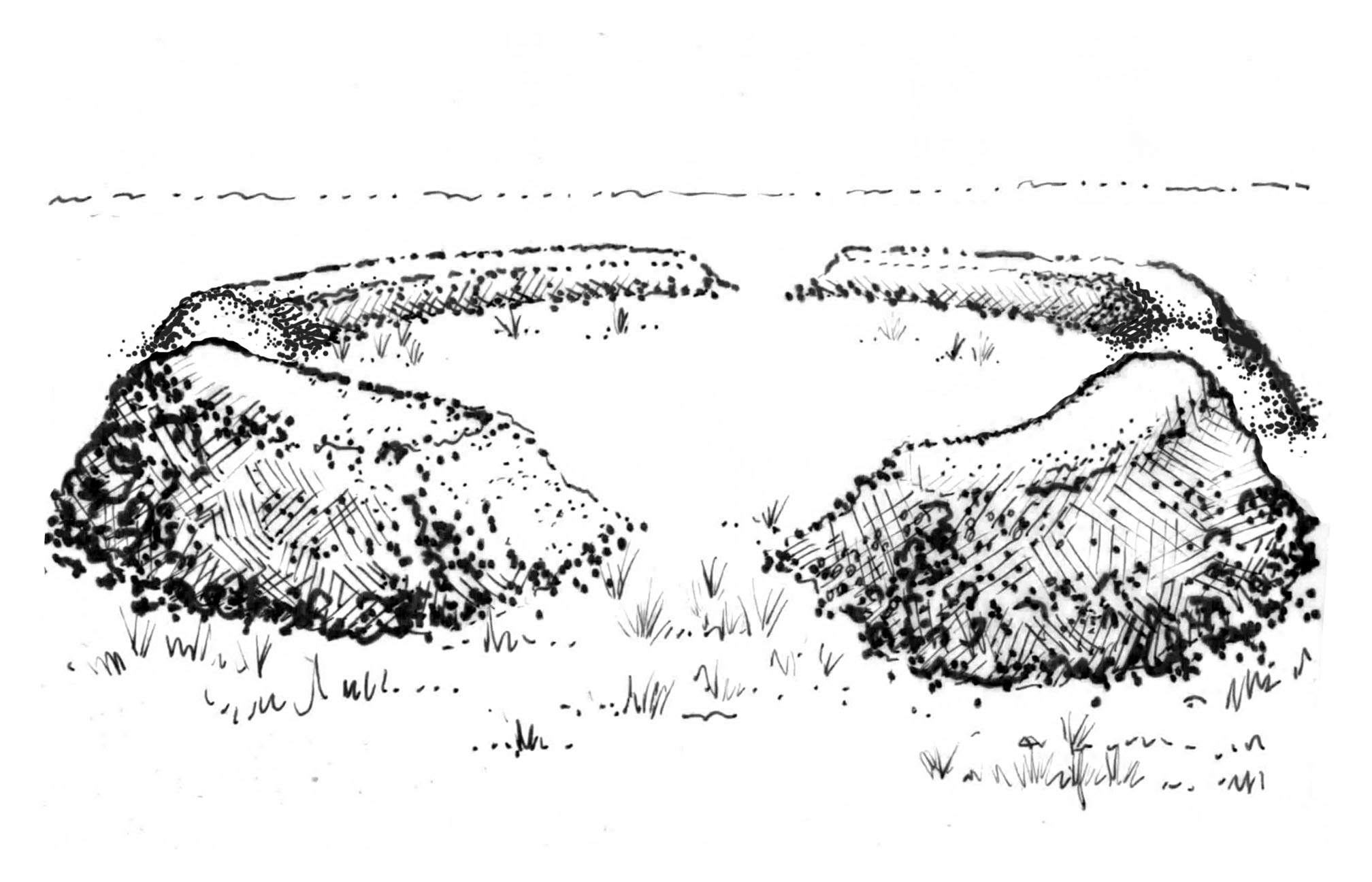
Type 2.

Type 3.
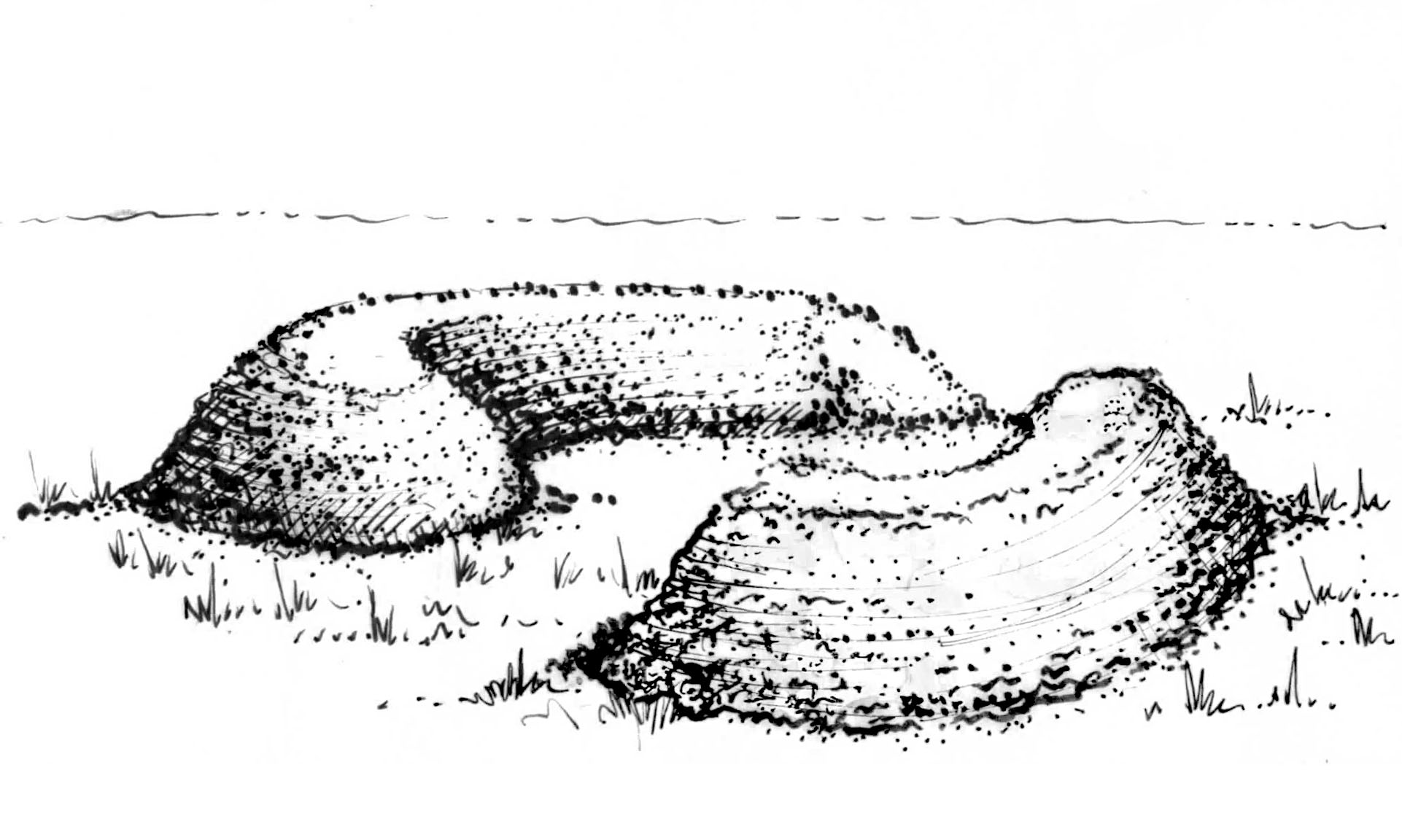
Type 4.
Illustration 2. Four types of curved hügelkultur with different designs and spatial uses.
Types of Hügelkultur
Anatomy of a Typical Hugelkultur
A typical hügelkultur has multiple layers of materials: large logs, branches, small twigs, grass clippings, manure, and topsoil. Illustration 3 shows the anatomy of a typical mound.

Illustration 3. Typical cross-section of a hügelkultur
Sizes and Slopes
A hügelkultur can be built at any scale. The length and height of the garden should be based on the site and available materials. The sides of a hügelkultur can be steeper or more gently sloped depending on your needs. Keep in mind that the steeper the sides are, the more difficult it may be to plant seeds without them washing away.
Depth & Borders
Hügelkultur can be built in-ground or above ground (see Illustration 4). Digging
into the ground can help capture more runoff, but may require more materials to create
the desired height. Also, depending on the depth and soil, digging may require additional
tools/machinery. A mound can also have base borders or be without borders (see Illustration
5 & 6). A border at the foot of the mound can stabilize the shape and prevent the
top layer from washing away. The border materials can be wood, brick, or stone. The
photographs from the built example hügelkultur in this article show an in-ground type
without a base border.

Illustration 4a. An in-ground hügelkultur.

Illustration 4b. An above-ground hügelkultur.
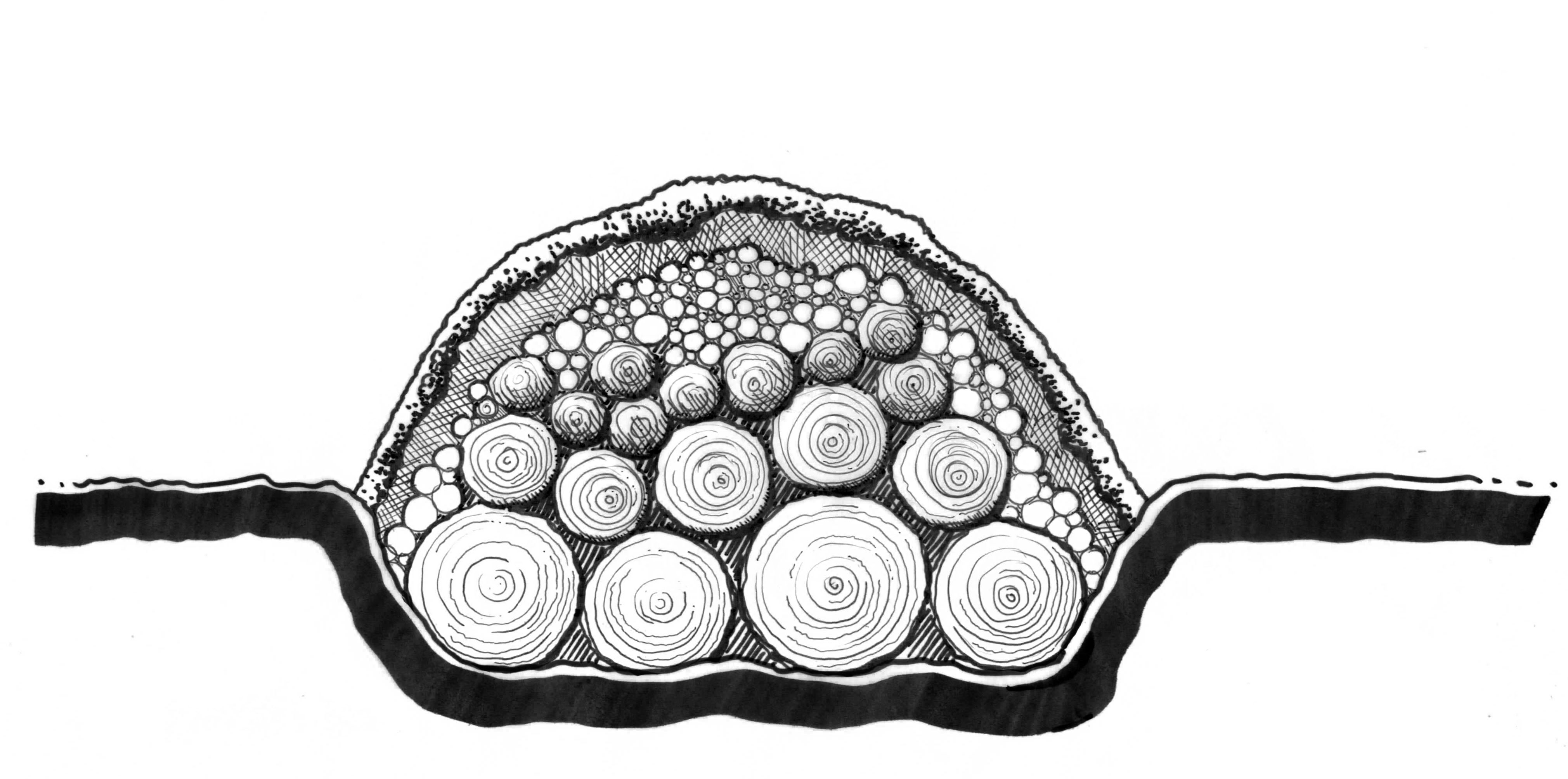
Illustration 5a. In-ground hügelkultur without border.

Illustration 5b. In-ground hügelkultur with wood border.

Illustration 5c. In-ground hügelkultur with stone border.

Illustration 6a. Above-ground hügelkultur without border.

Illustration 6b. Above-ground hügelkultur with wood border.

Illustration 6c. Above-ground hügelkultur with stone border.
Construction Process
Hügelkultur utilizes a lasagna gardening or sheet composting process, meaning one layer of material is stacked on top of another, alternating carbon and nitrogen sources of organic material that will decompose over time.
Basic Material List:
- Tree logs, branches, and leaves. Hardwoods are the best, including alder, aspen, birch, cottonwood, maple, oak, poplar, and willow. Avoid using the following: tree species that may have allopathic qualities (e.g. black walnut), trees that resist decay (i.e. cedars), cut green trees that sprout easily (e.g. willows), or wood with antifungal and antimicrobial properties, such as railroad ties and painted lumber.
- Manure, kitchen waste, and grass clippings that can be used for composting. These are nitrogen-rich materials, which help to maintain a proper carbon-to-nitrogen ratio in the decomposing process.
- Topsoil & mulch to cover the planting surface at the top of the mound one to two inches deep. If the hügelkultur is built slightly into the ground, you can use the excavated topsoil.
Construction Steps:
- Locate a relatively lower elevation spot on the property where the mound can capture
surface runoff. Ideally, this location receives 6 to 8 hours of sun for greater planting
options. Observe topography and construct a hügelkultur bed parallel with site contours
or perpendicular to the downhill flow of water. Water runoff will be captured in
the hügelkultur and encourage decomposition. See Illustration 7. Do not place the
hügelkultur at a parallel position with the water runoff direction, as it will not
be able to capture the runoff effectively. See Illustration 8.
Illustration 7. Correct. Place hügelkultur at a position of perpendicular to runoff direction.
Illustration 8. Incorrect. Do not place hügelkultur at a position of parallel to runoff direction.
- Dig a trench one to two feet deep and to your desired length and width (this may depend
on the amount of material you have collected). For a residential yard, a proper size
can be a rectangle shape at size of 3 ft x 6 ft. For a larger site, dimensions can
be scaled up. The Photo 1 below shows a trench much larger as it is built on a fairly
large property. Don’t forget to call Okie to locate your utility lines first.
Photo 1.
Photo 2. Lay down the largest logs at the bottom of the pit as the base layer
Photo 3. Add a layer of branches, then smaller twigs.
Photo 4. Fill in spaces between the logs and branches with leaves, manure, grass clippings, and/or kitchen waste.
Photo 5. When the mound is approximately 3 to 5 feet tall above ground, add one to two inches of topsoil.
Photo 6. Keep in mind that the height of the hügelkultur will continue to shrink as the materials break down over time.
Special note: Water each layer thoroughly before adding the next layer. Use a tamper to compact the pile after each layer is added to improve decomposition and reduce voids that can cause safety concerns. This hügelkultur was built at 20 ft x 8 ft x4 ft tall since the site was very large. A scaled down version such as 6 ft x 3 ft x 3 ft would be a more appropriate size for a typical residential yard. Photo 6 below shows its completion before planting. - Plant the hügelkultur.
After the final layer of topsoil is added to cover the hügelkultur, vegetables or other plants can be installed on the top and slopes of the mound. See Photo 7. Depending on the ratio of carbon to nitrogen materials you incorporate in the hügelkultur, new plants may need additional nitrogen fertilizer, as this nutrient can sometimes be inadequate for strong plant growth during the decomposition process. To fix nitrogen to the soil without adding fertilizer, plant legumes for the first couple of seasons. Legumes like peas can be a harvested crop or used as a cover crop.
Photo 7.
Vegetables planted in this hügelkultur example included pumpkin, multiple squash varieties,
asparagus, horseradish, and tomato.
A few things to pay attention about planting on a hügelkultur:
- Just as with composting, the best practice is to build the mound in fall for spring planting as it will benefit from curing time before planting.
- Hügelkultur beds can also be planted immediately. The above example was planted right away after the bed was raised.
- Both seedings or transplants will work, depending on what plants you are growing.
- Water the plants at their establishment stage with a simple hose. As the materials continue to decompose, the water retention in the hügelkultur will improve, and your plants will require less watering.
- Plants selection should still be based on amount of sun exposure the hügelkultur receives. Most vegetables require 6-8 hours of sunlight. Therefore, if you have a hügelkultur in the shade, it may not be an appropriate location for vegetables.
- A special note should be made that hügelkultur is a dynamic process where the wood and organic materials are biodegrading and sinking over time. In terms of maintenance, compost will need to be added before each planting season.
An example plant list:
| Cover Crops | Vegetables/Fruits | Ornamentals |
|---|---|---|
| Clover* | Tomatoes | Viburnum |
| Winterpeas* | Peppers | Salvia |
| Vetch* | Squash | Amsonia |
| Wheatgrass* | Melons | Agastache |
| Buckwheat | Blackberry | Helleborus |
| Cowpeas | Okra | Ornamental grasses |
*Cool season crops.
Additional plant information sources:
Cover Crops – Healthy Garden Soils, HLA-6436
Shrubs – Selecting Shrubs for the Landscape, HLA 6439
Summary
Overall, hügelkultur is a simple and practical method for gardening and urban farming. Yet it brings environmental, social, educational, economical benefits together. It is a true sustainable practice that should be widely advocated and practiced.
Additional resources:
Videos
Illustration credit: Illustrations were drawn by Carmen Wright, Landscape Architecture student at Oklahoma State University.

 Illustration 7. Correct. Place hügelkultur at a position of perpendicular to runoff direction.
Illustration 7. Correct. Place hügelkultur at a position of perpendicular to runoff direction.  Illustration 8. Incorrect. Do not place hügelkultur at a position of parallel to runoff direction.
Illustration 8. Incorrect. Do not place hügelkultur at a position of parallel to runoff direction.


